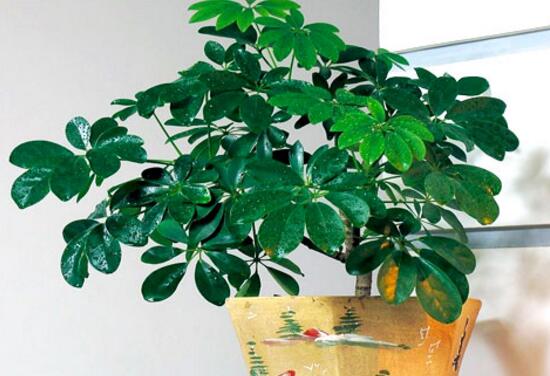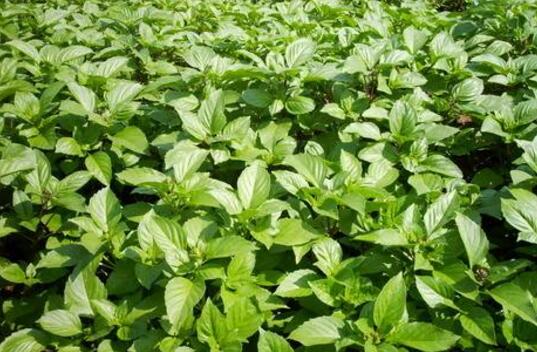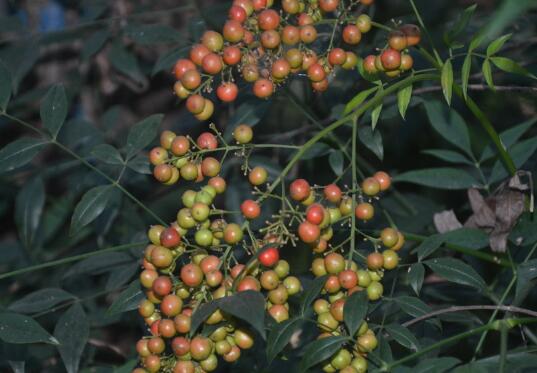What's going on with the falling leaves of Goose Feet? Improper watering, light discomfort/moving flowerpot damage
Goose foot wood, also known as duck foot wood, it leaves strange, like goose and duck feet, looks particularly beautiful. Because goosefoot evergreen, so deeply loved by flower friends, it is also potted at home by many families. But in the breeding process, because of the lack of management, many people will encounter the phenomenon of falling leaves, then what happened to the leaves of Goosefoot? Today, we will solve the problem by making up for everyone.
1. What happened to the leaves of Goose Palm Tree? It was not properly maintained.

Goosefoot tree adaptability is very strong, can go indoors, because some improper operation, or completely regardless of the breeding method of goosefoot tree, the result may appear deciduous situation, seriously affect the ornamental nature of the plant. As for what happened to the leaves of Goosefoot, specifically, there are five aspects: environmental mutation, improper watering, light discomfort, improper fertilization and pests. The following is a small series to tell you the solution.
5 reasons why the leaves fall off.
1. Move the basin frequently
To say what happened to the leaves of Goosefoot, we should consider environmental issues and see if they have recently moved flowerpots in the police. This is because when cultured indoors, it is not suitable for frequent pot transfer, especially for the flowering period of Goosefoot, which will accelerate the time of flower withering and cause leaves to fall.
Solution: In order to avoid this situation, we should put the goosefoot wood in a suitable place, do not often change the position. If moving the flowerpot causes the leaves to fall, remove the goosefoot tree as a whole with the soil, rinse off the soil with water, and then replant the pot with soil, taking care not to hurt the roots and whiskers.
2. Improper watering
Goosefoot tree likes moist environment, want it to grow well, moisture control is very important. Once watered improperly, it will cause goosefoot to lose leaves. For this, there are two situations:
① Too little watering, too dry pot soil, will lead to goose foot leaves droop off. Solution: proper watering, spring, summer, autumn three seasons about 3-4 days of watering, winter watering to reduce, keep 5-7 days can be once.
② Too much watering, too wet pot soil, blocked root respiration, a long time, easy to rot roots, the result is yellow leaves fall off. Solution: Move the potted plant to a ventilated place with light, so that the water evaporates quickly; when it is serious, cut off the rotten roots, replace them with new culture soil, and replant them.
3. Light discomfort
Goosefoot trees like half shade and need light, but the light should not be too strong. In this regard, novices are difficult to grasp this degree, resulting in light discomfort, causing goosefoot leaves to fall, there are also two situations:
① Insufficient light will affect the growth of plants, resulting in yellow leaves falling off. Solution: In addition to winter, plants can be placed outdoors or by windows for maintenance, avoiding direct light and ensuring sufficient scattered light.
② The light is too strong, and the leaves of Goosefoot turn yellow first and then gradually fall off under the sun; if they are moved from a place without sunlight to sunlight, the situation of falling leaves will be more serious. Solution: Move the potted plant to a ventilated dark place, maintain it for a period of time, and move it to a place with astigmatism.
4. Improper fertilization
Goosefoot wood in the growth process, need a certain amount of fertilizer, but we can not fertilize too much, so we must pay attention to the control of fertilizer. Once the fertilizer is not properly applied, there will also be a situation in which the leaves of Goosefoot fall off. For this, there are two situations:
① Insufficient fertilization, especially in the growing period, will lead to yellow leaves falling off. Solution: appropriate fertilization, in April to September period, irrigation once a month diluted fertilizer, to ensure that the pot soil nutrients are sufficient, not partial application of certain elements.
② Too much fertilizer, or too thick, will cause burning roots, the same phenomenon will appear to drop leaves. Solution: Remove the goosefoot wood from the basin, wash the roots with clean water, wash them several times in succession, then soak the roots in clean water, and replant them with new soil after the leaves are restored.
5. Diseases and pests
When Goosefoot is cultivated indoors, because the environment is too poor, or the management is careless, it is vulnerable to the invasion of diseases and insect pests, thus causing the phenomenon of leaf shedding. At this point, we should calm down, find specific pests and diseases, and then spray for prevention and control. As for what kind of medicine to spray, there is a detailed introduction in the pest control of Goosefoot, so I won't say more here.
Goosefoot leaves off the reason, in general, is more than 5 o 'clock, read the above content, we then encounter off the leaves, should know how to do it! In fact, falling leaves is caused by a cause, but it is often caused by a variety of factors, so when we encounter this situation, we must make a correct diagnosis, so that we can prescribe the right medicine.
How to do yellow leaves of goosefoot, 5 reasons and remedies/focus on light
Goosefoot wood, a healthy green plant, not only looks beautiful, but also absorbs nicotine and harmful gases to protect people's health, so many families will raise a pot. However, in the breeding process, many flower friends will encounter yellow leaf symptoms, that goosefoot leaves yellow how to do? For this, Xiaobian summed up 5 reasons, go and see together!
1. Yellow leaves of goosefoot, find out why
The yellowing of goosefoot leaves is a condition that many novices encounter during farming, which is usually caused by their failure to maintain them according to the farming methods of goosefoot. Encounter this kind of situation, flower friends must be very worried about it, but don't worry, as long as do remedial measures, goose foot wood or save.
2. Causes and remedies for yellowing of goosefoot leaves
1. Environmental mutation
As for the reason why the leaves of Goosefoot are yellow, the first thing to think of should be environmental problems, which can be divided into two situations: one is to buy Goosefoot in the flower market, because the environment changes greatly, Goosefoot can not adapt to it for a while, thus causing yellow leaf symptoms; The second is to put Goosefoot in a poor air environment, or air conditioning side, which will also cause yellow leaves to appear.
Remedy method: communicate with the store, understand the growth environment before buying goosefoot wood, and then we change to the same environment at home, after a period of time, the plant will return to health; if it is caused by poor indoor environment, it is very simple, improve the environment, simply clean up the garbage, and move the flowerpot to the ventilated place.
2, improper lighting
Goosefoot wood is a kind of indoor potted plant, it likes semi-shade environment, but avoid strong light, so giving appropriate light is necessary. However, many novices are difficult to control, resulting in improper lighting: ① insufficient light, will affect its growth, resulting in yellow leaves fall;② too strong light, goosefoot leaves are exposed, will also yellow fall.
Remedy method: When the light is insufficient, properly bask in the sun for the goose foot wood, and shade when the light is strong; when the light is too strong, move to the ventilated dark place, and water properly, and after the plant recovers, move to the semi-shade place for normal maintenance.
3. Improper watering
Goosefoot likes to be wet and does not tolerate drought. It needs sufficient water during its growth, but it cannot be watered too much, otherwise it is easy to appear yellow leaves: ① Too much watering, too wet pot soil, root system will have difficulty breathing, and a long time will cause root rot, resulting in yellow leaves falling;② Too little watering, too dry pot soil, resulting in plant water shortage leading to yellow leaves drooping and falling.
Remedy method: watering too much, move the potted plant to a ventilated place with light, let the water evaporate quickly, and change the pot soil when it is serious; watering too little, increase the amount and frequency of watering, but do not irrigate too much at a time, keep the soil moist, and spray water around the leaves or plants at high temperatures in summer.
4. Improper fertilization
In addition to watering, improper fertilization is also one of the reasons for the yellowing of Goosefoot leaves. In the process of growth, goosefoot wood needs certain nutrients. If the nutrients are insufficient, that is, the fertilizer is too little or not, the leaves will be deficient and yellow and fall off; but the fertilizer should not be too much, otherwise it will lead to too high soil concentration, resulting in burning roots and yellowing leaves.
Remedy method: Fertilization is insufficient, appropriate fertilization is given to Goosefoot wood, and attention should be paid to dilution with water every time; when fertilization is too much or too concentrated, the plant should be pulled out immediately, the root system should be cleaned, and the pot soil should be replanted.
5. Diseases and pests
In the process of cultivation, goosefoot wood will inevitably suffer from pests and diseases for various reasons, such as leaf spot disease, which will cause yellow leaves to fall seriously. In this regard, we should pay attention to do a good job of protective measures, and spray relevant chemicals, as for what to spray, in the goose foot tree pest control has a detailed introduction, here will not say more.
In general, goosefoot is still very easy to raise, but because many flower friends are novices, it is inevitable that there will be symptoms of yellow leaves. However, after reading the full text, I believe everyone has a bottom in mind, and the problem of leaf yellow can be remedied according to the above method. With regard to the yellowing of goosefoot leaves, Xiaobian introduced this, hoping to bring help to everyone.
How to raise goosefoot wood, goosefoot firewood/goosefoot wood breeding methods and precautions
Goosefoot wood, also known as goosefoot firewood, it is a common indoor potted plant, has a very good ornamental. In life, hotel halls, desks, libraries and other places, goosefoot trees can be seen everywhere, but also many people put it potted at home. So, how do you raise goosefoot trees? The following are the breeding methods and precautions of the selected goosefoot firewood/goosefoot wood in Xiaobian. They are very detailed. Friends who want to raise them must have a look ~
1. How to raise goosefoot trees and understand habits
Goosefoot, named for its inverted leaf shape, is a popular plant that many people plant in their homes. As for how to raise goosefoot wood, we must first understand its growth habits, and then satisfy it. In this regard, Xiao Bian will tell you in detail about the breeding method of goosefoot wood from soil, light, water and fertilizer, etc., and we will look down.
II. Cultivation methods and precautions of goosefoot wood
1. Soil
How to raise goosefoot wood, if it is indoors, the first natural choice of soil. According to the growth habits of goosefoot wood, it is best to choose sandy loam with deep soil, loose fertility and good drainage.
Xiao Bian recommended: we can use peat soil, pastoral soil, plus 1/4 coarse sand evenly mixed soil as cultivation soil. To ensure fertile soil, we can add a small amount of cake fertilizer in the soil as a base fertilizer.
2. Light
In the breeding methods and precautions of Goosefoot, light is naturally indispensable. Goosefoot wood likes half shade, avoid strong light direct, in indoor breeding, it is best to place in a bright scattered light sufficient place. If the light is appropriate, the leaves of Goosefoot will appear green and especially beautiful, so everyone must ensure that it has sufficient light.
Light requirements: spring and autumn, the outside temperature is appropriate, the light is not strong, we can move the goose foot wood to outdoor ventilation good maintenance, but to properly shade, so as not to cause the leaves to wither; summer light is very strong, flower pots can not be placed outdoors; winter light is weak, can be cultured outdoors.
3. Temperature
The right temperature is critical to good growth of goosefoot. 3-9 In September, the room temperature is maintained at 21~27℃; from September to March of the following year, the room temperature is maintained at 16~21℃. Under this condition, goosefoot will grow very well, and beautiful flowers will bloom.
Note: duck foot wood is not cold-resistant, winter room temperature should be kept above 10 ° C, if the room temperature is lower than 8 ° C, a long time, there will be goose foot leaves yellow symptoms; if it drops below 0 ° C, there will also be goose foot leaves off the situation. Therefore, in order to plant can give safe winter, we must pay attention to temperature regulation.
4. Watering/humidity
Anaconda grows well in an environment with sufficient soil moisture and high air humidity, so watering is very important in the cultivation method of Anaconda. Water goosefoot trees when the pot soil is not dry enough to keep the soil moist. When the weather is dry, spray around the plants to keep the humidity high.
Notes: pot soil can not lack water, otherwise there will be a large number of leaves of goosefoot; winter temperature is low, water evaporation is slow, to properly control watering, at this time watering a flower, it is easy to accumulate water, thus causing a large number of leaves. In addition, if it is a plastic pot to raise goosefoot wood, we should also pay attention to drainage.
5. Fertilization
How to raise goosefoot wood, finish watering, fertilization naturally also indispensable. In March-September, for the growth season of goosefoot wood, at this time should be every 2 to 3 weeks to apply some compound fertilizer or cake fertilizer water.
Note: To grow well, proper fertilization is necessary, but fertilization can not be too much, especially nitrogen fertilizer, once more, the leaf color will lose its original characteristics, there will be yellow leaves, seriously affecting the ornamental nature of the plant.
6, pruning
In addition to the above points, pruning is also something that everyone needs to do frequently. In the process of growth, goosefoot easy to sprout long branches, at this time in order to keep the plant shape neat and beautiful, it is necessary to prune the plant: before the annual bud germination, combined with the pot cut off the upper branches and leaves and part of the old roots.
7. Diseases and pests
Due to improper maintenance, goosefoot trees will be infested by diseases and insect pests, including leaf spot disease and anthracnose; pests mainly include leaf miner moths, red spiders, scale insects and thrips. Once infected, the ornamental value of Goosefoot will be greatly reduced. Therefore, after the discovery of pests and diseases, to prevent and control in time, specific how to do, in the goose foot tree pest control has a detailed introduction, here will not say more.
- Prev

How to water basil, how often is basil watered / watering does not need too much / attached method
Through basil's breeding method, we know that it is a plant that likes a dry environment, and it is necessary to create such an environment as far as possible in the usual maintenance process. Watering has become a key link, which can neither be watered more nor be watered for a long time.
- Next

How to raise bonsai of Phyllostachys pubescens, culture methods and matters needing attention / avoid stagnant water
Phyllostachys pubescens is a common woody flower in people's life. Its plant shape is beautiful and highly ornamental. However, it is not easy to raise this plant well, and there are many places that need to be paid attention to, so how to raise bonsai? What are the culture methods and matters needing attention of Phyllostachys pubescens
Related
- Fuxing push coffee new agricultural production and marketing class: lack of small-scale processing plants
- Jujube rice field leisure farm deep ploughing Yilan for five years to create a space for organic food and play
- Nongyu Farm-A trial of organic papaya for brave women with advanced technology
- Four points for attention in the prevention and control of diseases and insect pests of edible fungi
- How to add nutrient solution to Edible Fungi
- Is there any good way to control edible fungus mites?
- Open Inoculation Technology of Edible Fungi
- Is there any clever way to use fertilizer for edible fungus in winter?
- What agents are used to kill the pathogens of edible fungi in the mushroom shed?
- Rapid drying of Edible Fungi

